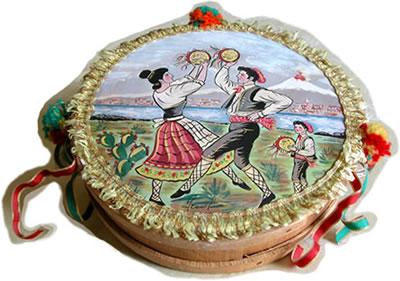Tammurriello (The Tamburello)
by Vincenzo Schisano
(Translated by Marianna Mastro)

Of Oriental origin (as all the musical instruments), the “tamburello” was diffused first in Spain
And later in Italy (especially in the South).
There are two types of the “Neapolitan Tamburello” (“o’ tammurriello”).
The first type is made of:
- a circular band of wood, whose diameter varies from 20 to 30 centimetres and its height is never more than 7 centimetres, decorated with a bunch of coloured ribbons;
- some tin saucers, called “’e cimbale” (the cymbals), are inserted in oval or square shaped cavities all along the wooden band mentioned above.
The second type has an animal skin (of sheep, goat or rabbit) applied on the surface of the circular wooden band.
The skin is the decorated with paintings representing scenes of “dance steps” or as in the “tammurreddu” (the tamburrello) of Calabria and Sicily are represented historical or epical scenes as well as landscapes (typical: the Gulf of Naples including the “smoking” Vesuvious).

The type of wood used for the second type is very cheap, fragile and porous; in the first type, instead, a solid type of wood and its quality is very superior (as in the “tamburello basco”).
Today, instead of the animal’s skin is even used a “ paper treated with a plastic process” (available for the unaware tourists causing a great damage to the image of the entire Neapolitan province).
The tamburello is played in the following way:
- beating the its skin with the entire hand;
- beating, with the palm of the hand, the edge between the wooden band and the skin;
- drumming with the fingers on the skin;
- shaking the tambourine, in order to produce only the sound of the tin saucers (transforming it into an “idiofono”;
- in the “male way”: holding it with the left hand and beating it with the right hand (just like the best musicians do);
- in the “female way”: holding it with the right hand and beating it with the left hand.
From all that has been mentioned above, consequently the real virtuous players of this instrument, which appears simple, are extremely rare; a few, in fact, have the ability, the rhythmical-musical instinct, the inventive ability capable to transform the tambourine in into an expressive instrument of an artistic high level, even in the sphere of the folk music.
Copyright © 2003, Vincenzo Schisano. All rights reserved.
